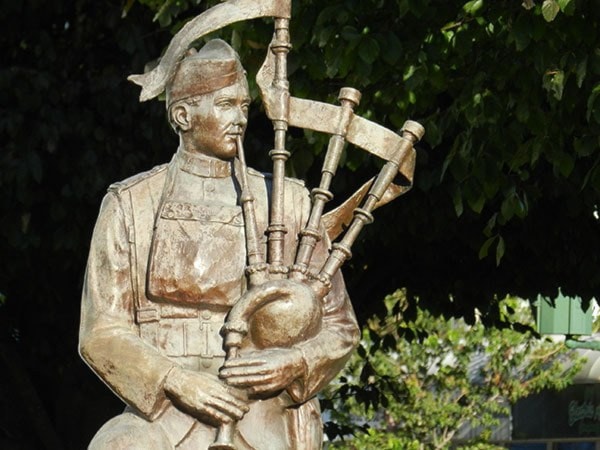The Battle of the Somme was into its fourth month when on Oct. 8, 1916 James Richardson primed his pipes and slogged into the mud of no man’s land.
Like all battles, the Somme was supposed to be over swiftly.
Called the Big Push, it was intended to punch a hole through German defences along a 22-kilometre front. Cavalry would sweep in through the gaps and bring an end the bloody stalemate that had existed since 1915.
The attack began July 1, 1916 – a date remembered not because of its success, but because it remains the single deadliest day of fighting in British history.
Nearly 20,000 allied troops were killed on that first day.
There would be no break out.
And there would be no swift victory.
Instead, the fight would grind on. Gone was the era of horse and sabre, and sweeping infantry maneuvers. They were replaced by the trench and machine gun. As the armies attempted to outflank each other following the early attacks of 1914, they built a network of trenches that would eventually stretch from the Swiss border to the channel sea.
Across from the allies in The Somme, German troops punctuated their defences with concrete strong points that extended deep into the chalky soil.
Intense artillery bombardment was intended to counter these defences and cut through the web of barbed wire that stretched in front of the trenches.
But even a barrage lasting seven days failed to destroy the German line. As advancing soldiers, most carrying 66 pounds of gear, were stopped by the tangled barbed wire, they were cut down by withering machine gun fire that survived the shelling.
The fighting continued over the ensuing months – with much the same result but under worsening conditions. The Somme became as well known for its glutenous mud as it would be for its murderous brutality.
“Nothing normal anywhere,” recalled Richardson’s commanding officer Col. C. W. Peck in a 1928 edition of the Chilliwack Progress. “Such devastation – such huddled heaps of dead – such death in life…”
James Richardson was six weeks from his 21st birthday as he prepared to climb the slimy parapet out of his trench. A member of the Seaforth Highlanders, he was one of a number of pipers used by British and Canadian armies to inspire troops in the face of battle. In all, more than 1,000 died.
As part of the Battle of Ancre Heights on Oct. 8, Richardson’s unit was ordered to take an enemy position, dubbed the Regina Trench. He wasn’t among the first pipers selected to join the attack, but when the advance faltered he pleaded to go.
Artillery had failed to cut through the barbed wire, leaving his comrades at the mercy of rifle and machine gun fire. Richardson, undaunted by the danger, “strode back and forth” on the field, playing his pipes and encouraging the troops forward.
But he wasn’t done yet. With the help of another soldier, he attacked a position and took two enemy prisoner. While escorting them back to the line, he realized he had left his bagpipes behind. Richardson was last seen going back to retrieve them.
Back in Chilliwack, Richardson’s family remained hopeful that James would be found alive. It wasn’t until 1918 that they received confirmation of his death. It took until 1919 for Chilliwack to learn Piper Richardson had been awarded the Victoria Cross – the highest military honour in the Commonwealth.
The medal was displayed in a store window in Chilliwack, accompanied by a letter from King George and the official description of the event – “An unrivalled tale of Scottish valour worthy of the finest traditions of Highland pipers.”
Inspiring as it was, Richardson’s actions would not win the day. The Battle of the Somme continued for another six weeks before the weather, the accumulated carnage, and the meagre gains from a final assault ended the fighting in mid November.
The cost was staggering. In all, more than 170,000 allied troops were killed for land that would only be lost in a German assault just 18 months later.
That didn’t matter at home. Richardson was a hero. And his tale of bravery in the in the face of danger was told time and time again. During the Second World War, the Piper Richardson VC chapter of the IODE used his inspiration to help the war effort. In 1953 legion Branch 4 unveiled a painting (above) commemorating his actions.
But like so much, memories fade with time. A 1972 fire destroyed the legion hall, taking with it the painting of Piper Richardson. In 1984 the IODE chapter bearing Richardson’s name disbanded.
Fortunately, there were some who would not allow Richardson’s heroism slip too far into the shades of the past. Today, thanks to their efforts, Piper Richardson is memorialized in bronze outside the Chilliwack Museum. And his pipes, rescued from the mud of the Somme, now hold a place of honour in the legislature building in Victoria.
Note: A special event commemorating the 100th anniversary of Richardson's death will be held at the Chilliwack Museum on Saturday, Oct. 8, beginning at 12:30 p.m.
